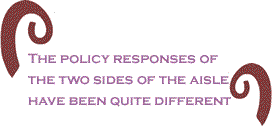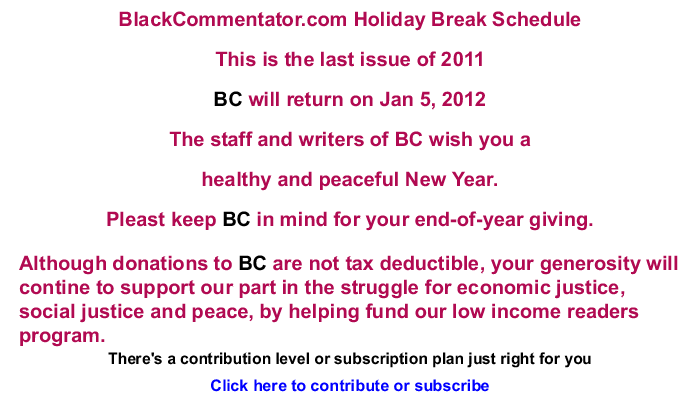|
It
was fascinating to observe the response, across the political
spectrum, to the November unemployment statistics. Pundits
on the right and left were quick to correctly point out
that there was hardly anything positive or hopeful about
the numbers.  Republican
Michele Bachmann, who opposes extending jobless benefits,
hypocritically crowed that “the lower numbers are being
propped up by huge numbers of Americans dropping out and
giving up on trying to find a job. The labor participation
rate dropped again to a tragically low percentage.” She
must be overjoyed. Earlier this year she expressed hoped
that high jobless numbers would help her Presidential campaign. Republican
Michele Bachmann, who opposes extending jobless benefits,
hypocritically crowed that “the lower numbers are being
propped up by huge numbers of Americans dropping out and
giving up on trying to find a job. The labor participation
rate dropped again to a tragically low percentage.” She
must be overjoyed. Earlier this year she expressed hoped
that high jobless numbers would help her Presidential campaign.
Others
have pointed to what is, under the circumstances, dismal
news pointing to the urgency of the crisis, its human toll,
and the imperative need for action to stimulate the economy
to create jobs.
For
U.S.
working people, “these are the worst times since the depth
of the Great Depression,” wrote Mort Zuckerman, editor-in-chief
of US News & World Report in the Financial
Times last week. “The unemployment rate, the highest
and most sustained in seven decades, improved last month
primarily because more than 300,000 people left the labor
force. And the situation is even grimmer than suggested
by the dismal statistics, calculated from a base of only
60,000 families. Analysts have concluded that the combined
unemployment and under-employment rate is slightly above
a staggering 20 per cent of the labor force.”
“Worse,
40 per cent of the jobless have been out of work for six
months or more, compared with 10 per cent in 2007,” wrote
Zuckerman, also a real estate executive. “The average period
of unemployment now exceeds 26 weeks, well above the previous
peak in July 1983 of just 21.2 weeks. This is critical because
the longer that people of any age are out of work, the less
likely they are to find another job.”
Economist
Dean Baker of the Center for Economic and Policy Research
noted that “Pretty much every sector of the economy saw
a decline in jobs, but those declines seemingly were offset
by a rise in the retail sector. We can speculate that the
rise in retail was a result of anticipating the holiday
season and therefore temporary jobs.”
Jobs
in construction fell for the month in a row while manufacturing
employment stayed about the same and public worker jobs
decreased by 20.000, bringing to 278,000 the number of public
sector jobs lost over the past year.
 “Over
the last three months, overall job growth has averaged 143,000.
It takes roughly 90,000 jobs to keep even with the growth
of the labor force,” wrote Baker. “At this rate, it will
take close to 200 months, or 16 years, to make up for the
10-million-job deficit in the economy.” “Over
the last three months, overall job growth has averaged 143,000.
It takes roughly 90,000 jobs to keep even with the growth
of the labor force,” wrote Baker. “At this rate, it will
take close to 200 months, or 16 years, to make up for the
10-million-job deficit in the economy.”
Zuckerman
says, “For hiring to occur at a pace that would support
recovery, we would need at least 500,000 more hires per
month. Instead, payrolls today are more than 7 million shy
of where they were when the Great Recession began.”
According
to the Department of Labor, employers added 120,000 jobs
in November and the unemployment rate dipped from 9 percent
in October to 8.6 percent. Experts say this was a result
of more people getting jobs and others giving up on their
job search altogether. And, it goes without saying, the
situation is much worse for African Americans and in other
minority communities. The black jobless rate rose slightly
from 15.1 percent to 15.5 percent compared with 8 percent
for whites.
For
Black workers the decline in labor force participation is
a major factor in what is actually a worsening situation
“The
drop in participation was entirely among women and especially
black women,” economist Baker wrote December 2 (Among married
women, employment rose by 194,000, so this was not a case
of women as second earners dropping out of the labor force.)
Participation numbers among white women fell by 199,000,
a decline of 0.2 percentage points. The drop among black
women was 164,000, a drop of 1.2 percentage points. These
monthly numbers are highly erratic, and it is likely that
at least part of this drop will be reversed in future months.
Nonetheless there had been a trend of declining participation
rates among both white and black women even prior to the
November plunge. This suggests that there is a real issue
of women losing access to jobs; although the December figures
may show some reversal.”

The
decline in women’s workforce participation rate is directly
related to the political right’s ongoing assault on public
workers.
“Buried
in the relatively positive numbers contained in the November
jobs report was some very bad news for those who work in
the public sector, the New York Times said editorially
December 4. “There were 20,000 government workers laid off
last month, by far the largest drop for any sector of the
economy, mostly from states, counties and cities.
“That
continues a troubling trend that’s been building for years,
one that has had a particularly harsh effect on black workers.
While the private sector has been adding jobs since the
end of 2009, more than half a million government positions
have been lost since the recession.
“In
most cases, states and cities had to lay off workers because
of declining tax revenues, or reduced federal aid because
of Washington’s inexplicable decision to focus more on the deficit in
the near term than on jobs.”
“Those
layoffs mean a lower quality of life when there are fewer
teachers, pothole repair crews and nurses,” the Times
continued.  And
then, citing a report by its reporter Timothy Williams the
previous week, the paper noted that the cutbacks “hit black
workers particularly hard.” And
then, citing a report by its reporter Timothy Williams the
previous week, the paper noted that the cutbacks “hit black
workers particularly hard.”
“Millions
of African-Americans - one in five who are employed - have
entered the middle class through government employment,
and they tend to make 25 percent more than other black workers,”
the editorial continued. “Now tens of thousands are leaving
both their jobs and the middle class. Chicago, for example, is laying off 212 employees in the upcoming fiscal
year, two-thirds of whom are black.”
“Many
Republicans, however, don’t regard government jobs as actual
jobs, and are eager to see them disappear. Republican governors
around the Midwest have aggressively tried to break the
power of public unions while slashing their work forces,
and Congressional Republicans have proposed paying for a
payroll tax cut by reducing federal employment rolls by
10 percent through attrition,” said the editorial. “That’s
200,000 jobs, many of which would be filled by blacks and
Hispanics and others who tend to vote Democratic, and thus
are considered politically superfluous.
“The
layoffs are not expected to end any time soon,” Williams
wrote. “The United States Postal Service, where about 25
percent of employees are black, is considering eliminating
220,000 positions in order to stay solvent, and areas with
large black populations - from urban Detroit
to rural Jefferson
County, Miss. - are struggling with budget problems that could also lead to
mass layoffs.
 “The
postal cuts alone - which would amount to more than one-third
of the work force - would be a blow both economically and
psychologically, employees say.” “The
postal cuts alone - which would amount to more than one-third
of the work force - would be a blow both economically and
psychologically, employees say.”
“But
every layoff, whether public or private, is a life, and
a livelihood, and a family. And too many of them are getting
battered by the economic storm,” said the Times.
There
was also scant good news for the group that is consistently
hit the hardest historically by joblessness and particularly
amid the current economic crisis. The seasonally adjusted
unemployment rate for African Americans between 16 and 19
years old was 39.6 percent in November. That’s down from
46.3 percent a year ago but up from 37.8 in October. The
black youth workforce participation rate – 37.4 percent
– has remained practically the same over the past 12 months.
The
average jobless level for young African Americans for the
third quarter of this year is 43.4 percent, up from 40.7
for the same period last year and 30.9 percent in 2008.
For
white teenagers the jobless rate is 21.4 percent, up from
20.8 percent in November 2010 and down from 21.8 percent
this October.
As
could be expected, the policy responses of the two sides
of the aisle have been quite different. With most – but
not all – of the Democrats seeking to extend existing jobless
benefits and the Republican mostly united around a proposal
to reduce them. GOP Congressional leaders are actually proposing
to decrease the number of weeks jobless benefits would be
available, execute new spending cuts and curb the pay of
federal employees. They have actually introduced a measure
to that effect into the House of Representatives that could
be voted on this week.

Meanwhile,
according to the Times, “If Congress does nothing,
benefits for the long-term unemployed will begin to expire
early next year, and two million people could lose benefits
by mid-February.”
It
is estimated that if Congress does not act before New Years
to extend benefits nearly 6 million people will lose federally
funded unemployment compensation over the course of next
year.
According to the Center for American Progress, 1.2 million
African Americans and 1 million Hispanics would benefit
from an extension of unemployment benefits.
The
proportion of unemployed African Americans over the age
of 16 who have been out of work for 27 weeks or longer as
of October 2011 is 48 percent. For Hispanics it’s 39 percent.
Then
there are the 99ers, those workers who have already exhausted
their unemployment benefits and about whom there is ever
hardly a mention in the major media (about half the jobless
are currently receiving no assistance at all). There is
a measure before Congress – HR 589 – which would give them
some assistance. During a recent House of Representatives
debate on jobless benefit extension, the only member to
bring the matter up was Rep. Barbara Lee (D - Ca) who has,
as noted by Crewof42.com, brought the issue up “repeatedly
in conversations with the White House, on the House floor,
at press conferences and in meetings.”
 In
California alone
an estimated 305,000 workers will be left without income
if the benefits are not extended. The state’s unemployment
rate for young people 20 to 24 years old is 19 percent.
For African Americans as a whole the rate is nearly 20 percent
and close to 15 percent for Latinos. In
California alone
an estimated 305,000 workers will be left without income
if the benefits are not extended. The state’s unemployment
rate for young people 20 to 24 years old is 19 percent.
For African Americans as a whole the rate is nearly 20 percent
and close to 15 percent for Latinos.
“With
California unemployment
hovering around 12 percent, job seekers far outnumber actual
jobs,” said California Labor Federation Executive Secretary-Treasurer
Art Pulaski. “It’s deplorable that Republicans in Congress
and their special interest friends are attempting to sever
the one remaining lifeline for California’s jobless. California’s Republican members of Congress need
to get their priorities in order. Our state’s jobless need
an extension of benefits far more than the richest 1 percent
needs yet another fat tax break.”
“The
outlook is bleak,” wrote Zuckerman. “Over 20 per cent of
companies say that employment in their firms will never
return to pre-recession levels. Another 40-plus per cent
say revenues would have to rise around 40 per cent to return
to pre-recession employment levels. Moreover, most of the
new jobs available don’t match the pay, the hours or the
benefits of the positions that vanished during the recession.
Millions of Americans face a lost decade, living from paycheck
to paycheck, struggling to pay their bills, having to borrow
money and go deeper into debt.”
“The
prospect of losing benefits during the holiday season takes
a tremendous toll on those suffering the hardship of unemployment,”
said Pulaski
 BlackCommentator.com
Editorial Board member Carl Bloice is a writer in
San Francisco, a member of the
National
Coordinating Committee of the Committees of Correspondence
for Democracy and Socialism and formerly worked for a healthcare union. Click
here
to contact Mr. Bloice. BlackCommentator.com
Editorial Board member Carl Bloice is a writer in
San Francisco, a member of the
National
Coordinating Committee of the Committees of Correspondence
for Democracy and Socialism and formerly worked for a healthcare union. Click
here
to contact Mr. Bloice.
|

